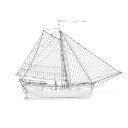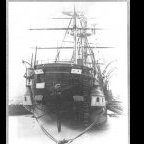Supplies of the Ship Modeler's Handbook are running out. Get your copy NOW before they are gone! Click on photo to order.
×
-
Posts
3,084 -
Joined
-
Last visited
Reputation Activity
-
 Jaager got a reaction from mtaylor in Is it worth it to make your own deadeyes
Jaager got a reaction from mtaylor in Is it worth it to make your own deadeyes
You may wish to explore what is realistic as far as what is the compensation for a ship model built from a kit.
The impression that I get is that they sell for about what is retail for the original kit.
It is possibly different for a scratch built model of a unique subject built by someone with an existing reputation as an artist,
Even then, based on a dollars per hour, it is unlikely to match what a skilled senior professional in the trades would receive.
For a kit, red state minimum wage is probably a dream.
-
 Jaager got a reaction from Boccherini in Is it worth it to make your own deadeyes
Jaager got a reaction from Boccherini in Is it worth it to make your own deadeyes
You may wish to explore what is realistic as far as what is the compensation for a ship model built from a kit.
The impression that I get is that they sell for about what is retail for the original kit.
It is possibly different for a scratch built model of a unique subject built by someone with an existing reputation as an artist,
Even then, based on a dollars per hour, it is unlikely to match what a skilled senior professional in the trades would receive.
For a kit, red state minimum wage is probably a dream.
-
 Jaager got a reaction from DaveBaxt in Cutting out gun ports
Jaager got a reaction from DaveBaxt in Cutting out gun ports
Theory here:
It is difficult to get an acceptable finish on a gunport by cutting it and finishing the sides of the cut.
It may be a successful procedure to make the opening oversize and inserting a frame of a sill and lintel and having a veneer layer where the frame timbers would be.
If you are set on all rectangular openings, the same jig can be used for every port on a particular deck to glue up the framing. It is then a matter of shimming each frame. If the frames are mounted before placing the outside planking, .....
-
 Jaager got a reaction from flying_dutchman2 in Is it worth it to make your own deadeyes
Jaager got a reaction from flying_dutchman2 in Is it worth it to make your own deadeyes
You may wish to explore what is realistic as far as what is the compensation for a ship model built from a kit.
The impression that I get is that they sell for about what is retail for the original kit.
It is possibly different for a scratch built model of a unique subject built by someone with an existing reputation as an artist,
Even then, based on a dollars per hour, it is unlikely to match what a skilled senior professional in the trades would receive.
For a kit, red state minimum wage is probably a dream.
-
 Jaager got a reaction from mtaylor in Cutting out gun ports
Jaager got a reaction from mtaylor in Cutting out gun ports
Theory here:
It is difficult to get an acceptable finish on a gunport by cutting it and finishing the sides of the cut.
It may be a successful procedure to make the opening oversize and inserting a frame of a sill and lintel and having a veneer layer where the frame timbers would be.
If you are set on all rectangular openings, the same jig can be used for every port on a particular deck to glue up the framing. It is then a matter of shimming each frame. If the frames are mounted before placing the outside planking, .....
-
 Jaager got a reaction from DaveBaxt in Cutting out gun ports
Jaager got a reaction from DaveBaxt in Cutting out gun ports
An aspect of gunports that seems to be often missed:
The sides of the ports are parallel to the frames, not perpendicular to the LWL.
The sills and lintels are parallel to the deck at the port location. In the middle there is little or no difference port to port. At the ends, each port is individual in shape.
The ports are parallelograms with vertical sides. A stick used as a gauge for every port on a particular deck produces an inauthentic result.
The gun truck or skid sits on the deck. The barrel tracks parallel to the deck.
-
 Jaager got a reaction from Some Idea in Cutting out gun ports
Jaager got a reaction from Some Idea in Cutting out gun ports
An aspect of gunports that seems to be often missed:
The sides of the ports are parallel to the frames, not perpendicular to the LWL.
The sills and lintels are parallel to the deck at the port location. In the middle there is little or no difference port to port. At the ends, each port is individual in shape.
The ports are parallelograms with vertical sides. A stick used as a gauge for every port on a particular deck produces an inauthentic result.
The gun truck or skid sits on the deck. The barrel tracks parallel to the deck.
-
 Jaager got a reaction from Keith Black in Cutting out gun ports
Jaager got a reaction from Keith Black in Cutting out gun ports
An aspect of gunports that seems to be often missed:
The sides of the ports are parallel to the frames, not perpendicular to the LWL.
The sills and lintels are parallel to the deck at the port location. In the middle there is little or no difference port to port. At the ends, each port is individual in shape.
The ports are parallelograms with vertical sides. A stick used as a gauge for every port on a particular deck produces an inauthentic result.
The gun truck or skid sits on the deck. The barrel tracks parallel to the deck.
-
 Jaager got a reaction from mtaylor in Cutting out gun ports
Jaager got a reaction from mtaylor in Cutting out gun ports
An aspect of gunports that seems to be often missed:
The sides of the ports are parallel to the frames, not perpendicular to the LWL.
The sills and lintels are parallel to the deck at the port location. In the middle there is little or no difference port to port. At the ends, each port is individual in shape.
The ports are parallelograms with vertical sides. A stick used as a gauge for every port on a particular deck produces an inauthentic result.
The gun truck or skid sits on the deck. The barrel tracks parallel to the deck.
-
 Jaager got a reaction from thibaultron in Cutting out gun ports
Jaager got a reaction from thibaultron in Cutting out gun ports
An aspect of gunports that seems to be often missed:
The sides of the ports are parallel to the frames, not perpendicular to the LWL.
The sills and lintels are parallel to the deck at the port location. In the middle there is little or no difference port to port. At the ends, each port is individual in shape.
The ports are parallelograms with vertical sides. A stick used as a gauge for every port on a particular deck produces an inauthentic result.
The gun truck or skid sits on the deck. The barrel tracks parallel to the deck.
-
 Jaager got a reaction from bruce d in Cutting out gun ports
Jaager got a reaction from bruce d in Cutting out gun ports
An aspect of gunports that seems to be often missed:
The sides of the ports are parallel to the frames, not perpendicular to the LWL.
The sills and lintels are parallel to the deck at the port location. In the middle there is little or no difference port to port. At the ends, each port is individual in shape.
The ports are parallelograms with vertical sides. A stick used as a gauge for every port on a particular deck produces an inauthentic result.
The gun truck or skid sits on the deck. The barrel tracks parallel to the deck.
-
 Jaager got a reaction from robert952 in Cutting out gun ports
Jaager got a reaction from robert952 in Cutting out gun ports
An aspect of gunports that seems to be often missed:
The sides of the ports are parallel to the frames, not perpendicular to the LWL.
The sills and lintels are parallel to the deck at the port location. In the middle there is little or no difference port to port. At the ends, each port is individual in shape.
The ports are parallelograms with vertical sides. A stick used as a gauge for every port on a particular deck produces an inauthentic result.
The gun truck or skid sits on the deck. The barrel tracks parallel to the deck.
-
 Jaager got a reaction from Capella in Building my own budget lathe for wood model ship building - looking for tips and advice on my ideas
Jaager got a reaction from Capella in Building my own budget lathe for wood model ship building - looking for tips and advice on my ideas
Dowels are made using a punch type cutter. The grain is often not dead straight. If the grain is at a slope or angle - over time the dowel may follow the curve of the grain.
Using a froe on a straight grain board to split out straight grain sticks to turn into spars may save having a model with dog leg spars.
I use a lot of 4" ratchet clamps. I want squeeze out pressure. The Irwin clamps that I have are poor at generating any sort of pressure. The only ones that I found that work to my needs are the HF clamps with the big grey wing nut.
The Widget Supply, MM, and small grey nut HF clamps have not done the job for me.
-
 Jaager got a reaction from mtaylor in Building my own budget lathe for wood model ship building - looking for tips and advice on my ideas
Jaager got a reaction from mtaylor in Building my own budget lathe for wood model ship building - looking for tips and advice on my ideas
A traditional froe is a wooden handle with a right angle straight blade at the bottom. It was used to split out Cedar shingles. The blade is a wedge that splits along the grain instead of cutting the wood. The wood peels apart.
I have a smaller version - sort of looks like a paint stirring stick in shape - from a Japanese tool site - it was designed to split Bamboo.
You make a new yard - it is straight when finished - the wood was from a dowel - the dowel came from the outer part of the board and the grain is curved - over time, the yard seeks equilibrium - the rest of the board is gone, so no restraint - and it follows the grain - I am just calling the bend "a dog's leg". I do not know of any actual spars that are anything but straight - so dog's leg is slang for an unwanted bend.
Spar is the umbrella term for masts, yards, and booms. I do not know if it is official, but it seems to be.
I do POF. I use all bends - (two paired frames with each overlapping each butt joint of the other) - I like tight gaps - the closer the join, the stronger the bond. No wood to wood joint will have enough PVA squeeze out to starve the joint (in a healthy situation)- especially if both surfaces are 100% covered first - wood is hydrophyllic - unlike metal - and too much clamping pressure (unhealthy) would crush the outer wood fibers before too little PVA is left . I guess Basswood could too easily crush, but I class that species as being inappropriate for much of anything important. For my needs, the Irwin clamp was a failure. Another factor is to not use too fine a grit sanding medium on a wood surface that will be at a glue joint. I like 220 but that is right at the edge of being too smooth. The wood wants some "tooth". Too fine a surface and it becomes metal-like.
-
 Jaager got a reaction from Capella in Building my own budget lathe for wood model ship building - looking for tips and advice on my ideas
Jaager got a reaction from Capella in Building my own budget lathe for wood model ship building - looking for tips and advice on my ideas
A traditional froe is a wooden handle with a right angle straight blade at the bottom. It was used to split out Cedar shingles. The blade is a wedge that splits along the grain instead of cutting the wood. The wood peels apart.
I have a smaller version - sort of looks like a paint stirring stick in shape - from a Japanese tool site - it was designed to split Bamboo.
You make a new yard - it is straight when finished - the wood was from a dowel - the dowel came from the outer part of the board and the grain is curved - over time, the yard seeks equilibrium - the rest of the board is gone, so no restraint - and it follows the grain - I am just calling the bend "a dog's leg". I do not know of any actual spars that are anything but straight - so dog's leg is slang for an unwanted bend.
Spar is the umbrella term for masts, yards, and booms. I do not know if it is official, but it seems to be.
I do POF. I use all bends - (two paired frames with each overlapping each butt joint of the other) - I like tight gaps - the closer the join, the stronger the bond. No wood to wood joint will have enough PVA squeeze out to starve the joint (in a healthy situation)- especially if both surfaces are 100% covered first - wood is hydrophyllic - unlike metal - and too much clamping pressure (unhealthy) would crush the outer wood fibers before too little PVA is left . I guess Basswood could too easily crush, but I class that species as being inappropriate for much of anything important. For my needs, the Irwin clamp was a failure. Another factor is to not use too fine a grit sanding medium on a wood surface that will be at a glue joint. I like 220 but that is right at the edge of being too smooth. The wood wants some "tooth". Too fine a surface and it becomes metal-like.
-
 Jaager got a reaction from Bob Cleek in Building my own budget lathe for wood model ship building - looking for tips and advice on my ideas
Jaager got a reaction from Bob Cleek in Building my own budget lathe for wood model ship building - looking for tips and advice on my ideas
A traditional froe is a wooden handle with a right angle straight blade at the bottom. It was used to split out Cedar shingles. The blade is a wedge that splits along the grain instead of cutting the wood. The wood peels apart.
I have a smaller version - sort of looks like a paint stirring stick in shape - from a Japanese tool site - it was designed to split Bamboo.
You make a new yard - it is straight when finished - the wood was from a dowel - the dowel came from the outer part of the board and the grain is curved - over time, the yard seeks equilibrium - the rest of the board is gone, so no restraint - and it follows the grain - I am just calling the bend "a dog's leg". I do not know of any actual spars that are anything but straight - so dog's leg is slang for an unwanted bend.
Spar is the umbrella term for masts, yards, and booms. I do not know if it is official, but it seems to be.
I do POF. I use all bends - (two paired frames with each overlapping each butt joint of the other) - I like tight gaps - the closer the join, the stronger the bond. No wood to wood joint will have enough PVA squeeze out to starve the joint (in a healthy situation)- especially if both surfaces are 100% covered first - wood is hydrophyllic - unlike metal - and too much clamping pressure (unhealthy) would crush the outer wood fibers before too little PVA is left . I guess Basswood could too easily crush, but I class that species as being inappropriate for much of anything important. For my needs, the Irwin clamp was a failure. Another factor is to not use too fine a grit sanding medium on a wood surface that will be at a glue joint. I like 220 but that is right at the edge of being too smooth. The wood wants some "tooth". Too fine a surface and it becomes metal-like.
-
 Jaager got a reaction from Bob Cleek in Building my own budget lathe for wood model ship building - looking for tips and advice on my ideas
Jaager got a reaction from Bob Cleek in Building my own budget lathe for wood model ship building - looking for tips and advice on my ideas
Dowels are made using a punch type cutter. The grain is often not dead straight. If the grain is at a slope or angle - over time the dowel may follow the curve of the grain.
Using a froe on a straight grain board to split out straight grain sticks to turn into spars may save having a model with dog leg spars.
I use a lot of 4" ratchet clamps. I want squeeze out pressure. The Irwin clamps that I have are poor at generating any sort of pressure. The only ones that I found that work to my needs are the HF clamps with the big grey wing nut.
The Widget Supply, MM, and small grey nut HF clamps have not done the job for me.
-
 Jaager got a reaction from mtaylor in Building my own budget lathe for wood model ship building - looking for tips and advice on my ideas
Jaager got a reaction from mtaylor in Building my own budget lathe for wood model ship building - looking for tips and advice on my ideas
Dowels are made using a punch type cutter. The grain is often not dead straight. If the grain is at a slope or angle - over time the dowel may follow the curve of the grain.
Using a froe on a straight grain board to split out straight grain sticks to turn into spars may save having a model with dog leg spars.
I use a lot of 4" ratchet clamps. I want squeeze out pressure. The Irwin clamps that I have are poor at generating any sort of pressure. The only ones that I found that work to my needs are the HF clamps with the big grey wing nut.
The Widget Supply, MM, and small grey nut HF clamps have not done the job for me.
-
 Jaager got a reaction from East Ender in New Again?
Jaager got a reaction from East Ender in New Again?
Unlike plastic, it is neigh on to impossible to totally ruin a wooden ship kit. Worse comes to worst, all of the material can be replaced with the natural material from outside sources, and started over as scratch. It is better schooling too.
One of the tricks with carving is to use tools that work well.
For more than light removal, StewMac has a pair of small razor files that are peachy keen.
For the sort of sanding that the hull needs, it is probably better to always have a wood backing on the sandpaper.
Rubber cement - both surfaces coated, allowed to dry, and joined, fixes the paper to the backing and makes for easy renewal.
No matter how badly the hull looks, it will still look better than any POB hull - unless the POB hull is totally filled between the molds. And if that is done, it is essentially the same as a carved hull.
It is difficult to irreversibly damage a solid wood hull. If too much is removed, the loss can be replaced.
If it is just a little, wood flour mixed with PVA makes a very strong layer, but it will be tougher to remove than the original wood after it sets up. For a deeper patch, scab a layer of wood veneer - Pine works.
When you get the shape to match your templates, even if it is ugly, that is easy to hide.
The kit may offer this suggestion, but a solid carved hull makes an excellent support for a layer of actual planking.
The planking wood should be thin and of a scale appropriate species of hardwood. Being thin, the planks can be properly spilled by using a steel straight edge and a sharp knife. Since the hull is being gridled beyond its dimension, thin is best.
Using an appropriate species of wood can turn a chore into a joy.
The model will look better.
-
 Jaager got a reaction from Ryland Craze in New Again?
Jaager got a reaction from Ryland Craze in New Again?
Unlike plastic, it is neigh on to impossible to totally ruin a wooden ship kit. Worse comes to worst, all of the material can be replaced with the natural material from outside sources, and started over as scratch. It is better schooling too.
One of the tricks with carving is to use tools that work well.
For more than light removal, StewMac has a pair of small razor files that are peachy keen.
For the sort of sanding that the hull needs, it is probably better to always have a wood backing on the sandpaper.
Rubber cement - both surfaces coated, allowed to dry, and joined, fixes the paper to the backing and makes for easy renewal.
No matter how badly the hull looks, it will still look better than any POB hull - unless the POB hull is totally filled between the molds. And if that is done, it is essentially the same as a carved hull.
It is difficult to irreversibly damage a solid wood hull. If too much is removed, the loss can be replaced.
If it is just a little, wood flour mixed with PVA makes a very strong layer, but it will be tougher to remove than the original wood after it sets up. For a deeper patch, scab a layer of wood veneer - Pine works.
When you get the shape to match your templates, even if it is ugly, that is easy to hide.
The kit may offer this suggestion, but a solid carved hull makes an excellent support for a layer of actual planking.
The planking wood should be thin and of a scale appropriate species of hardwood. Being thin, the planks can be properly spilled by using a steel straight edge and a sharp knife. Since the hull is being gridled beyond its dimension, thin is best.
Using an appropriate species of wood can turn a chore into a joy.
The model will look better.
-
 Jaager got a reaction from jud in New Again?
Jaager got a reaction from jud in New Again?
Unlike plastic, it is neigh on to impossible to totally ruin a wooden ship kit. Worse comes to worst, all of the material can be replaced with the natural material from outside sources, and started over as scratch. It is better schooling too.
One of the tricks with carving is to use tools that work well.
For more than light removal, StewMac has a pair of small razor files that are peachy keen.
For the sort of sanding that the hull needs, it is probably better to always have a wood backing on the sandpaper.
Rubber cement - both surfaces coated, allowed to dry, and joined, fixes the paper to the backing and makes for easy renewal.
No matter how badly the hull looks, it will still look better than any POB hull - unless the POB hull is totally filled between the molds. And if that is done, it is essentially the same as a carved hull.
It is difficult to irreversibly damage a solid wood hull. If too much is removed, the loss can be replaced.
If it is just a little, wood flour mixed with PVA makes a very strong layer, but it will be tougher to remove than the original wood after it sets up. For a deeper patch, scab a layer of wood veneer - Pine works.
When you get the shape to match your templates, even if it is ugly, that is easy to hide.
The kit may offer this suggestion, but a solid carved hull makes an excellent support for a layer of actual planking.
The planking wood should be thin and of a scale appropriate species of hardwood. Being thin, the planks can be properly spilled by using a steel straight edge and a sharp knife. Since the hull is being gridled beyond its dimension, thin is best.
Using an appropriate species of wood can turn a chore into a joy.
The model will look better.
-
 Jaager got a reaction from mtaylor in New Again?
Jaager got a reaction from mtaylor in New Again?
Unlike plastic, it is neigh on to impossible to totally ruin a wooden ship kit. Worse comes to worst, all of the material can be replaced with the natural material from outside sources, and started over as scratch. It is better schooling too.
One of the tricks with carving is to use tools that work well.
For more than light removal, StewMac has a pair of small razor files that are peachy keen.
For the sort of sanding that the hull needs, it is probably better to always have a wood backing on the sandpaper.
Rubber cement - both surfaces coated, allowed to dry, and joined, fixes the paper to the backing and makes for easy renewal.
No matter how badly the hull looks, it will still look better than any POB hull - unless the POB hull is totally filled between the molds. And if that is done, it is essentially the same as a carved hull.
It is difficult to irreversibly damage a solid wood hull. If too much is removed, the loss can be replaced.
If it is just a little, wood flour mixed with PVA makes a very strong layer, but it will be tougher to remove than the original wood after it sets up. For a deeper patch, scab a layer of wood veneer - Pine works.
When you get the shape to match your templates, even if it is ugly, that is easy to hide.
The kit may offer this suggestion, but a solid carved hull makes an excellent support for a layer of actual planking.
The planking wood should be thin and of a scale appropriate species of hardwood. Being thin, the planks can be properly spilled by using a steel straight edge and a sharp knife. Since the hull is being gridled beyond its dimension, thin is best.
Using an appropriate species of wood can turn a chore into a joy.
The model will look better.
-
 Jaager got a reaction from Dave_E in New Again?
Jaager got a reaction from Dave_E in New Again?
Unlike plastic, it is neigh on to impossible to totally ruin a wooden ship kit. Worse comes to worst, all of the material can be replaced with the natural material from outside sources, and started over as scratch. It is better schooling too.
One of the tricks with carving is to use tools that work well.
For more than light removal, StewMac has a pair of small razor files that are peachy keen.
For the sort of sanding that the hull needs, it is probably better to always have a wood backing on the sandpaper.
Rubber cement - both surfaces coated, allowed to dry, and joined, fixes the paper to the backing and makes for easy renewal.
No matter how badly the hull looks, it will still look better than any POB hull - unless the POB hull is totally filled between the molds. And if that is done, it is essentially the same as a carved hull.
It is difficult to irreversibly damage a solid wood hull. If too much is removed, the loss can be replaced.
If it is just a little, wood flour mixed with PVA makes a very strong layer, but it will be tougher to remove than the original wood after it sets up. For a deeper patch, scab a layer of wood veneer - Pine works.
When you get the shape to match your templates, even if it is ugly, that is easy to hide.
The kit may offer this suggestion, but a solid carved hull makes an excellent support for a layer of actual planking.
The planking wood should be thin and of a scale appropriate species of hardwood. Being thin, the planks can be properly spilled by using a steel straight edge and a sharp knife. Since the hull is being gridled beyond its dimension, thin is best.
Using an appropriate species of wood can turn a chore into a joy.
The model will look better.
-
 Jaager got a reaction from GrandpaPhil in New Again?
Jaager got a reaction from GrandpaPhil in New Again?
Unlike plastic, it is neigh on to impossible to totally ruin a wooden ship kit. Worse comes to worst, all of the material can be replaced with the natural material from outside sources, and started over as scratch. It is better schooling too.
One of the tricks with carving is to use tools that work well.
For more than light removal, StewMac has a pair of small razor files that are peachy keen.
For the sort of sanding that the hull needs, it is probably better to always have a wood backing on the sandpaper.
Rubber cement - both surfaces coated, allowed to dry, and joined, fixes the paper to the backing and makes for easy renewal.
No matter how badly the hull looks, it will still look better than any POB hull - unless the POB hull is totally filled between the molds. And if that is done, it is essentially the same as a carved hull.
It is difficult to irreversibly damage a solid wood hull. If too much is removed, the loss can be replaced.
If it is just a little, wood flour mixed with PVA makes a very strong layer, but it will be tougher to remove than the original wood after it sets up. For a deeper patch, scab a layer of wood veneer - Pine works.
When you get the shape to match your templates, even if it is ugly, that is easy to hide.
The kit may offer this suggestion, but a solid carved hull makes an excellent support for a layer of actual planking.
The planking wood should be thin and of a scale appropriate species of hardwood. Being thin, the planks can be properly spilled by using a steel straight edge and a sharp knife. Since the hull is being gridled beyond its dimension, thin is best.
Using an appropriate species of wood can turn a chore into a joy.
The model will look better.
-
 Jaager got a reaction from Keith Black in New Again?
Jaager got a reaction from Keith Black in New Again?
Unlike plastic, it is neigh on to impossible to totally ruin a wooden ship kit. Worse comes to worst, all of the material can be replaced with the natural material from outside sources, and started over as scratch. It is better schooling too.
One of the tricks with carving is to use tools that work well.
For more than light removal, StewMac has a pair of small razor files that are peachy keen.
For the sort of sanding that the hull needs, it is probably better to always have a wood backing on the sandpaper.
Rubber cement - both surfaces coated, allowed to dry, and joined, fixes the paper to the backing and makes for easy renewal.
No matter how badly the hull looks, it will still look better than any POB hull - unless the POB hull is totally filled between the molds. And if that is done, it is essentially the same as a carved hull.
It is difficult to irreversibly damage a solid wood hull. If too much is removed, the loss can be replaced.
If it is just a little, wood flour mixed with PVA makes a very strong layer, but it will be tougher to remove than the original wood after it sets up. For a deeper patch, scab a layer of wood veneer - Pine works.
When you get the shape to match your templates, even if it is ugly, that is easy to hide.
The kit may offer this suggestion, but a solid carved hull makes an excellent support for a layer of actual planking.
The planking wood should be thin and of a scale appropriate species of hardwood. Being thin, the planks can be properly spilled by using a steel straight edge and a sharp knife. Since the hull is being gridled beyond its dimension, thin is best.
Using an appropriate species of wood can turn a chore into a joy.
The model will look better.















